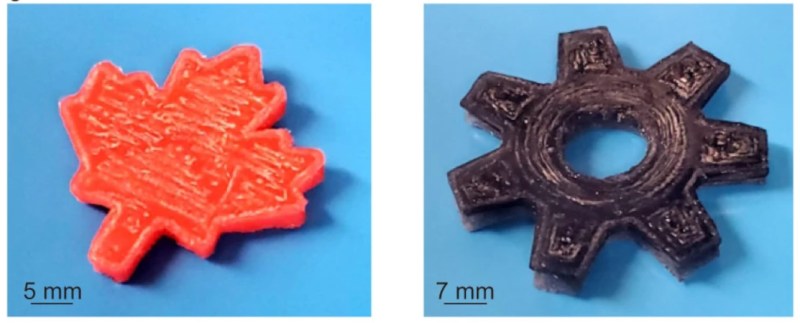Canadian researchers at Concordia University want to change how you do 3D printing. Instead of using light or thermal mechanisms, they propose using ultrasound-activated sonochemical reactions. Sounds wild? You can see a video about it below, or read the paper in Nature.
The idea is that sound causes bubbles of cavitation. This requires a focused ultrasonic beam which means you can actually print through items that are transparent to ultrasonic energy. Wherever the cavitation bubbles form, liquid polymer turns solid.
As you might expect, the bubbles don’t make a nice clean edge, but we’ve seen conventional 3D prints that didn’t look any better. The idea that you might be able to print things inside of other things offers some interesting possibilities. In particular, it might be possible to inject a polymer into someone’s joints, and then 3D print structures inside their body with very little invasiveness.
We have to wonder if the ultrasonic energy could be moved around without moving the transducer the way a mirror can move a laser. On the other hand, the ultrasonic energy is relatively high, so maybe that’s not feasible. The transducers they are using, by the way, are commercially-available and used for medical purposes, so if you wanted to try this, it doesn’t seem like there is anything too exotic to deal with. Since they are for medical purposes, they probably aren’t cheap, but maybe something could be scrounged.
Usually sound isn’t something you want in your ordinary 3D printers unless you are playing music on them. We don’t know if the usual levitation transducer would work in this context, but you can always try.
















ultrasonic transducers are used in humidifiers and parts cleaners
and all sorts of other stuff,I would bet that the ultrasonic recievers used in medical gear are the exotic parts,that and the
imageing software took a million hours to build
the energy availible in cavitation bubbles is huge,high speed
filming of cavitation bubbles forming around hydrofoils,revealed
a flash of light as the bubbles colapse,which when it gets going
will eat titanium
that wasn’t easy to read
as such, difficult to understand
Easy enough that I understood it.
Given the wavelengths of ultrasonic energy, I suspect that the resolution would be poor and I’d bet that most “outside” materials would try to absorb a goodly percentage of that energy. Not sure I’d want bubbles forming inside my body either.
Couldn’t the ultrasonic focus point be steered around using a phased array kind of like how some radars work? That would be interesting and basically solid-state. No moving parts (unless you count the vibrating elements producing the sound)
I thought of that too, but then I considered the wavelengths involved.
Yeah on second thought—that would make things very tricky lol
There are medical devices that use a “bladder” which can be pressed against the body and whose shape can be altered and controlled to place the energy source at one foci of an ellipse and the “in-body” target at the other foci. The energy produced is very high at the foci but of much lower density in other areas away from the foci.
Back in the 90’s, these were being developed for things like destroying kidney stones and the like – I could see that working on the “in-body” applications here…
Thought that was immersing body in a tub of water.
Phased array ultrasound is already used in medical imaging, so it’s totally possible. It depends on the medium, but 10 MHz ultrasound has a wavelength of about 0.15 mm.
Old medical devices are some of my favorite things to scrounge parts from. You never know what you might find. Just the other day I found this really cool metal that is always warm to the touch and glows in the dark! What should I make from it?
Unless that medical device happens to have a cobalt 60 source in it.. /s
If you get sick anytime soon go to the hospital and bring that metal with you so they know what happen
So old That tecnology……they have a big printers Somewhere um da sky …just see the crop circles….
What?